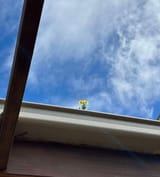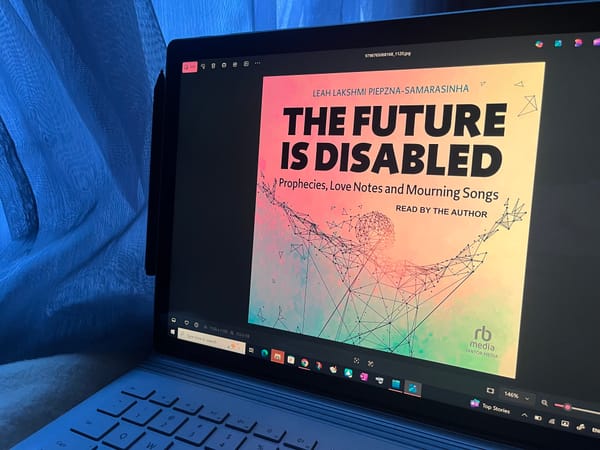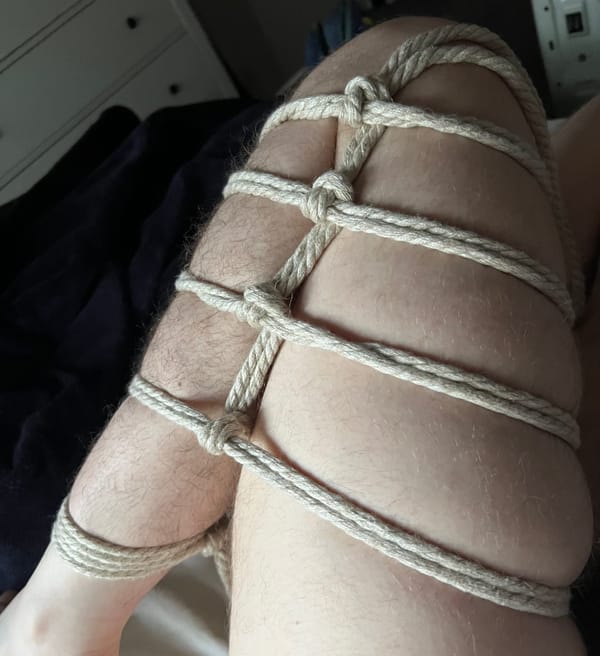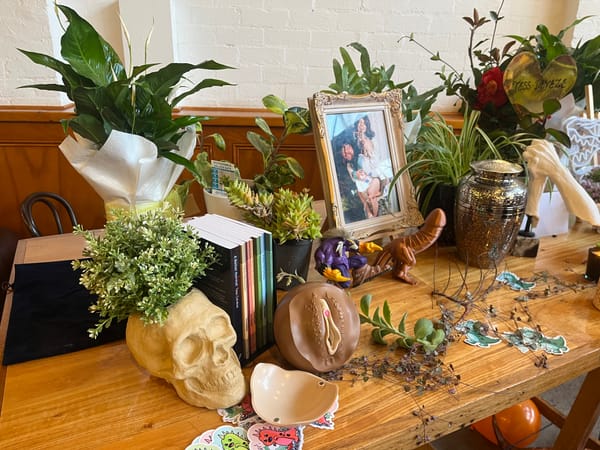On “The Future is Disabled” - Reflections and Sharing, Part 1
Wherein I talk about my new favourite book !!
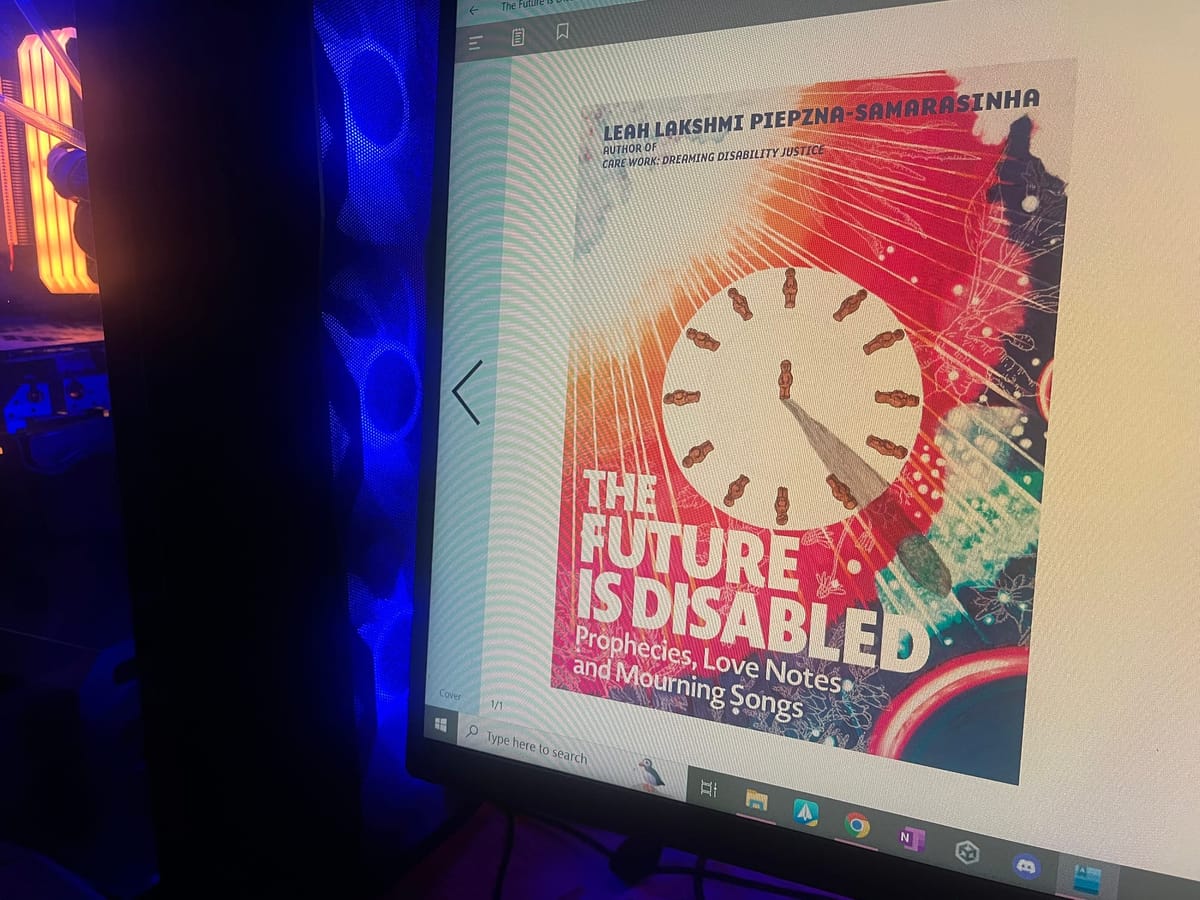
Welcome to part 1 of me talking about the non-fiction book I recently finished, The Future Is Disabled by Leah Lakshmi Piepzna-Samarasinha! This first part will be me talking about the book generally, then the second part will be me sharing particular chapters that I enjoyed and my takeaways from them.
I think this book is so fantastic and important for anyone looking to build a better world - whether that be through caring for those immediately around you or enacting widespread systemic change (because as the author argues, these two things are not so different!!)
I hope you enjoy my reflections and the learning that I share from this book!
I loved this book. I loved it soooo much. It felt like a soothing balm, an antidote to the constant 24/7 gaslighting that is living in a climate changing, genocidal, pandemic denying society as a disabled person fiercely passionate in her belief that the world does not have to be like this.
This book made me feel like my experiences and understanding of the reality of my life and the world were entirely real. It made me trust my beliefs and feelings and affirmed that they were rational. It grounded me as a disabled person in the long history of disabled culture, community and grief, granting me access to knowledge of my disabled kin and ancestors and security in knowing that our disabled struggles today are not starting from scratch: they are built on centuries of crip wisdom. They are built on the social and physical crip technologies that Blak, Indigenous and People of Colour specifically have been inventing and utilising for centuries.
This book was such a valuable portal into the world of disability justice writing and actors, not just in how Piepzna-Samarasinha wrote and explained things, but in how they introduced me to a wide variety of other people’s work in disability justice spaces past and present. Knowing where the information you need is, knowing where the people fighting with you are, is so important (as a chapter is dedicated in this book to arguing, haha). This book was an entryway to all of that.
My experience reading The Future Is Disabled struck an incredible balance of affirming things I already knew, extending thoughts and ideas I had into new realms of possibility and nuance, and teaching me things that were entirely new.
To tell you what this book was broadly about, I’m going to tell you about the book’s introduction.
The introduction boldly acts as an abstract for the rest of the book - which as someone who loves signposting i LOVEEEE.
Piepzna-Samarasinha covers the ways in which disabled people are told by abled society that the world would be better off without us and we would be better off not in the world, the ways we are erased from our own futures, and the reasons it is crucial that we create futures for ourselves anyway.
They cover the ways in which, due to the ongoing and minimised COVID-19 pandemic, every single person in the world is becoming disabled or more disabled either through the physical mechanisms of being constantly reinfected by viruses and/or the trauma of being surrounded by so much death, sickness and neglect. They ask — what if this wasn’t a bad thing?
They express, vehemently, how disabled skills are vital to creating the future we dream of, how the revolution requires disabled people and our skills in order to actually succeed in creating and maintaining a liberated society free from oppression. Why does Piepzna-Samarasinha believe so strongly in the disabled future? It’s simple, they say: “I am a pragmatist. I want us to win.”
Finally — crucially — they express how the skills, knowledge, teachings and actions that they describe and speak on throughout the book come from disabled Queer, Trans BIPOC. The author explains how they are writing this book as a gift to their fellow QTBIPOC crips, that the rest of us are welcome to listen in but queercrips of colour, specifically, are their intended readers. This context is vital to the way they write.
This book is not an explainer. It’s not disability/racial/queer-issues 101. When Piepzna-Samarasinha writes that cops are bastards, that doctors and the medical industrial complex do extreme damage to QTBIPOC, disabled and fat people - they don't explain why. They don't justify themself. They state this as a fact - because it is.
When they write about ASL or CART, POTS or EDS, they don’t introduce the acronym or write a long explainer about what it is. They don’t need to. Their intended audience knows. And if you don’t know, you google. And then you learn yourself, rather than relying on their labour to teach you the basics.
What results is a refreshingly open and uncluttered prose, not bogged down in specifics or definitions or justifications for the basic terms needed to talk about QTBIPOC disability. Piepzna-Samarasinha can get right into the complex and the nuanced, the hard and the healing.
Contextualising modern day disabled QTBIPOC within their long history, Piepzna-Samarasinha shares a quote from Black abolitionist organizer and science fiction writer Walidah Imarisha that really stuck with me:
“For those of us from communities with historic collective trauma, we must understand that each of us is already science fiction walking around on two legs. Our ancestors dreamed us up and then bent reality to create us… I am my ancestors’ wildest dreams.”
This introduction wonderfully captures the entire spirit of the book. As the start of the introduction is freely available in articles the author has written online, I want to share the first few pages of the book with you here, as it is perfectly captures so many of the great things that Piepzna-Samarasinha writes about in this book. Imagine we are at a book club and I am reading you an excerpt :)
Excerpt from The Future is Disabled
by Leah Lakshmi Piepzna-Samarasinha
I believe in the disabled future.
This is a radical statement. Disabled people aren’t supposed to be alive, take up space, exist—joyfully, complicatedly, thrivingly, ornery-ly—in the present. But the future? Nah. Double nah.
In the Bad Future of all kinds of dystopian imaginings, disabled people are either everywhere, with our pathetic, pain-filled,dysfunctional, broken bodyminds. We’re the tragic autistic son in Children of Men who can’t look up from his devices, the “disfigured” ugly babies produced by toxic waste and climate change. We’re a cautionary tale told to children, warning them to fight climate change and fascism or just look what will happen. On the other hand, in so much utopian social justice–oriented science fiction, it’s unquestioned that in the good utopian future, disabled people don’t exist. Everyone eats organic, and disabled babies are eliminated before birth through genetic selection that no one ever calls eugenics. In the happy future, we’re all dead. And isn’t it better that way?
Fuck that.
“Crip bodies were built for space travel. Crip minds already push the outer limits,” Alice Wong, founder of the Disability Visibility Project, tweeted in 2016. “We already master usage of breathing apparatuses and can handle challenging situations.”
A 2020 Wired article wrote about the buried history of disabled and Deaf people “selected as some of the earliest astronaut trainees, because Deaf people were less likely get nauseous and used sign to communicate; because pooping is a major problem in space and it’s easier when you already have a colostomy bag. Disabled and Deaf gain—the brilliance within our divergent bodyminds—help us take root amongst the stars, to paraphrase Octavia Butler. As white Jewish queer disabled writer Carrie Kaufman recently wrote, “Where do you (the abled) go when you leave us behind? Is it worth it?”
At the core of my work and life is the belief that disabled wisdom is the key to our survival and expansion. Crip genius is what will keep us all alive and bring us home to the just and survivable future we all need. If we have a chance in hell of getting there.
Yet a major way ableism works is to erase us from ideas of the future. The science fiction future, sure, but also the everyday future of having any idea of what a disabled adulthood or elderhood could look like. Ableism isolates and keeps disabled, Deaf and neurodivergent people from finding disabled, Deaf and neurodivergent communities. It’s common for parents or teachers to tell some disabled children they’re “not like the others,” for parents of autistic, Deaf or disabled kids to deny our identities. Sometimes, especially for BIPOC people, this can be the best survival strategy we know, but being kept from each other also kills.
Most people still draw a blank when you say the words “disabled community”—like, what is that? Autistic and disabled special-ed student Cole Sorensen says, “Until I started college, I had never met an adult who was like me. I had other disabled friends, sure, but with no model of what my life could look like after graduation, I couldn’t imagine much of a future for myself at all.”
This is why I believe some of disability justice’s most import- ant work lies in how we’ve created space for BIPOC people (and, secondarily, Others) to identify as disabled, chronically ill, Deaf or neurodivergent, through our creation of Black- and brown- centered disabled, sick, Deaf and neurodivergent communities and politics.
Community building isn’t always seen as “real activism” (whatever) but the work we do to create disabled Black and brown community spaces, online forums, hashtags, and artwork is lifesaving because it creates space for disabled BIPOC to come out as disabled. I mean big organized spaces, parties, and cultural events, and I also mean the disabled BIPOC version of “Hey, do you want some of my fries?”: one disabled BIPOC person being friendly and Initiating Hangout Space with another, who might not be ready to be out yet. It’s very difficult to organize for survival, power, and pleasure when people can’t even admit they go to this school, you know?
Disability justice (DJ) spaces filled with disabled Black and brown people are crucial spaces for disabled, sick, Deaf, and neurodivergent BIPOC people to witness possible futures for ourselves, as we take in other Black and brown disabled people as possibility models and friends. I could do it like that. I could have a life like that. I could expect my access needs be met like that. I could just say, “Hey, I need a chair or captions,” easy like that. I could be disabled like that.
Many Black and brown disabled people have been gate-kept from claiming disabilities and excluded from mainstream disabled spaces for years by blatant and covert racism perpetuated by white disabled people and/or by the idea, Yeah, I know about that group but they’re all white people, making it not safe or not worth the risk to go through the door.
I’ve witnessed a fair bit of resentment and anger over the past decade from white disabled groups/people at the success of disability justice groups to attract masses of disabled BIPOC and ally BIPOC people. White- majority and -lead disabled groups’ racism and lack of intersectional analysis and leadership, in tandem with the general ableism of the world, prevented that kind of community buy-in for decades. I didn’t make the rules, though, and it’s just a fact that racism is an impediment to movement-building and activist wins.
DJ community spaces lead by Black and brown disabled people are revolutionary spaces because they are often the only ones where disabled BIPOC feel safe to uncloset ourselves and speak our vulnerable and raw disabled BIPOC stories. I always insist on doing BIPOC- only disabled workshops because I know that when BIPOC who haven’t had space to think about disability from a Black or brown perspective before finally get that space, our disabled BIPOC stories that come out—of pesticide and chemical poisoning from working in the fields and housecleaning, immigration denials and deportations, police murder, abuse in prisons and immigration camps, medical experimentation and abuse on Black and brown bodies—are not ones we will ever feel comfortable sharing in front of white people.
Doing DJ work in BIPOC communities means going into it knowing the stories of intergenerational trauma and pain from racist ableism are going to come out and there must be space to hold them with care. As painful as they are, those stories and the spaces that hold them are places where we are birthing disability justice futures—our individual futures as disabled Black and brown people, and the big collective futures we are making together. They are spaces of “crip doulaing,” a term created by disability justice organizer Stacey Park Milbern to describe the ways disabled people support/mentor newly disabled people in learning disabled skills (how to live on very low spoons, drive a wheelchair, have sex/redefine sexuality, etc.) A doula supports someone doing the work of childbirth; a crip doula is a dis- abled person supporting another disabled person as they do the work of becoming disabled, or differently disabled, of dreaming a new dis- abled life/world into being. This is a very Black and brown disabled, collective way of doing the work.
It’s radical to imagine that the future is disabled. Not just tentatively allowed to exist, not just ok I guess there’s one white guy with a wheelchair, cool, diversity. But a deeply disabled future: a future where disabled, Deaf, Mad, neurodivergent body-minds are both accepted without question as part of a vast spectrum of human and animal ways of existing, but where our cultures, knowledge and communities shape the world.
What would a future look like where the vast majority of people were disabled, neurodivergent, Deaf, Mad? What would a world radically shaped by disabled knowledge, culture, love, and connection be like? Have we ever imagined this, not just as a cautionary tale or a scary story, but as a dream?
Thank you for reading with me! That’s all from me for this post - stay tuned for part two where I share some specific chapters/essays in the book that I found particularly fascinating, important or challenging :D
